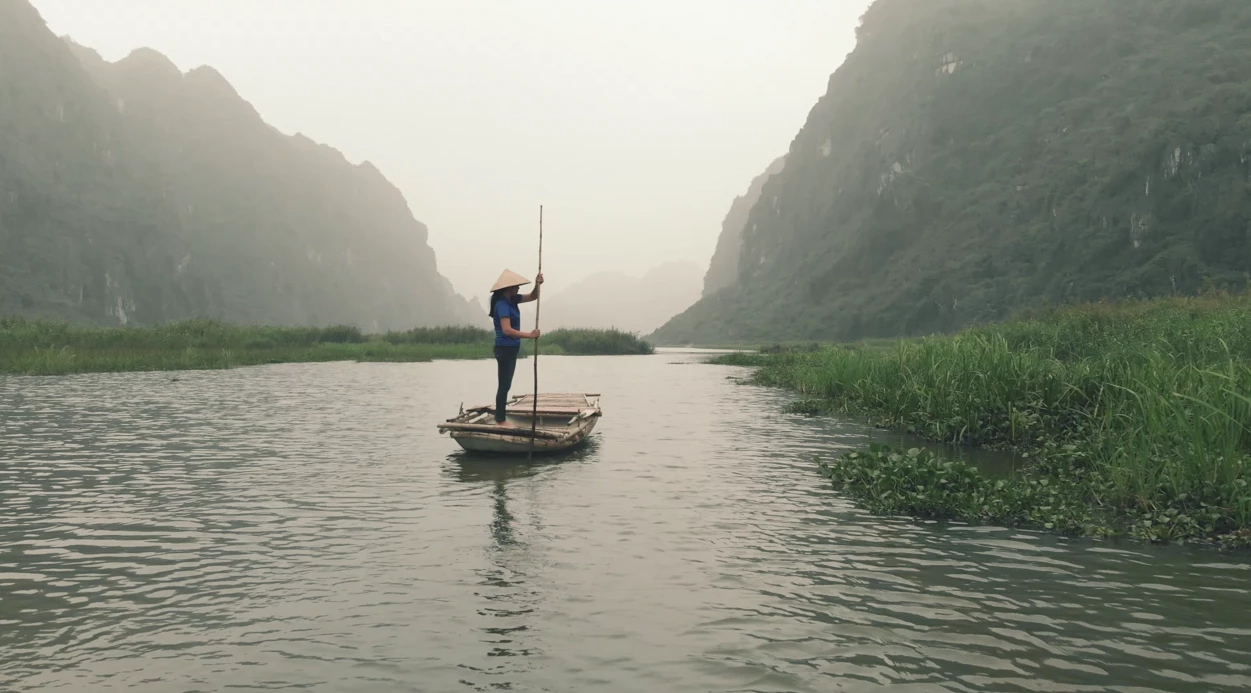
Nguyen thi Ngoan rows skillfully through the reedy wetland filled with seagrass and snails. She has rowed since she was 16 while her grandparents worked in the nearby rice fields. Now 32, she has two children and lives in a village near Van Long Nature Reserve—home to the critically endangered primate, the Delacour’s langur.
Established by the government of Vietnam in 2001, Van Long Nature Reserve serves as a tourist destination for both domestic and international visitors who yearn for a serene getaway from the scurrying motorbikes on the streets of Hanoi.
Earning less than $2 per day, Nguyen is one of 500 men and women who own a boat in this region. A laminated copy of the number of the boat and associated household is kept at the boat harbor; a simple system of roll call and rotation has been set up by the local community that gives each household an equitable primary income supplemented only by small scale, seasonal farming. A small portion of their livelihoods goes to protecting the landscape and preserving the Delacour’s langur. Of the estimated 200 Delacour’s Langur left in the world, about half live in the Van Long Nature Reserve (FFI 2016). This community in northwestern Vietnam are aware that by preserving the Delacour langur and its habitat, more tourists will visit the area. As Nguyen says, “the local people have protected the langur as if it is their lives.”
In 2017, approximately 50,000 tourists visited the nature reserve. Compared to other tourist destinations, this number may be small, but for a niche destination like Van Long, the volume of visitors is impressive. Overall, travel and tourism contribute almost 10% to Vietnam’s GDP and in 2016 that came to $18.4 billion. The plan is to increase the number of tourists, which will put more pressure on the country’s natural resources and potentially lead to “over-tourism”.
To accommodate a massive influx of tourists, Vietnam will need to improve its infrastructure and make available large quantities of food, water, and other natural resources. The downside of increased number of tourists is that it can lead to residents being pushed out of their homes, a loss of cultural identity, and landscapes become polluted, degraded, or destroyed. As one of the world’s most biologically diverse countries, the need to preserve Vietnam’s biodiversity is vital to their economic wealth and environment health.
The World Bank-led Global Wildlife Program (GWP) has been partnering with the government of Vietnam in a project funded by the Global Environmental Facility (GEF). The project has just been launched with the aim to preserve biodiversity through strengthened policy and enforcement, as well as to develop guidelines for establishing sustainable nature-based tourism in several national parks in the country.
These guidelines will help Vietnam’s government to create the kind of enabling environment needed for nature-based tourism to flourish. The guidelines will:
- Protect the country’s natural assets by helping park authorities understand the value of landscapes in generating revenues for conservation and increase enforcement to protect the endangered primates
- Promote high-value, low impact tourism across nature reserves in Vietnam by making sure that there is a set limit on the number of tourists visiting a landscape to prevent over-tourism and degradation of these already threatened ecosystems
- Share benefits equitably by creating a mechanism through which communities are formally included in the management of natural resources and have access to revenue- sharing from tourism development
For a landscape like Van Long that is threatened by large scale infrastructure and whose only hope for raising funds for conservation is through nature-based tourism, it is key that the local councils and management authorities focus more on developing high-value nature-based tourism rather than investing in increasing tourist numbers. This would reduce the over-use of natural resources by limiting the impact that each tourist has on the surrounding environment. As a high-end destination, Van Long Nature Reserve would then be able to provide all households in the community a chance to diversify their livelihoods beyond rowing boats, to include cultural experiences, selling local arts and crafts, promoting homestays, and even training the community to be tour guides. The development of such a sustainable nature-based tourism model would guarantee the long-term benefits to the local community, and preserve the habitat for the Delacour langurs.
It’s evident in Van Long Nature Reserve that communities care deeply about the environment. You can see it in Nguyen’s eyes when she describes the pristine landscape and her motivation to preserve it for her children. See for yourself.
This video will be presented at the 6th GEF Assembly in Danang, Vietnam on June 26, 2018.
Related:
- International Conference on Nature-Based Tourism in Conservation Areas
- World Bank Group: Supporting Sustainable Livelihoods through Wildlife Tourism
- World Bank Group: An Introduction to Tourism Concessions
- Tourism for Development: 20 Reasons Sustainable Tourism Counts for Development


Join the Conversation